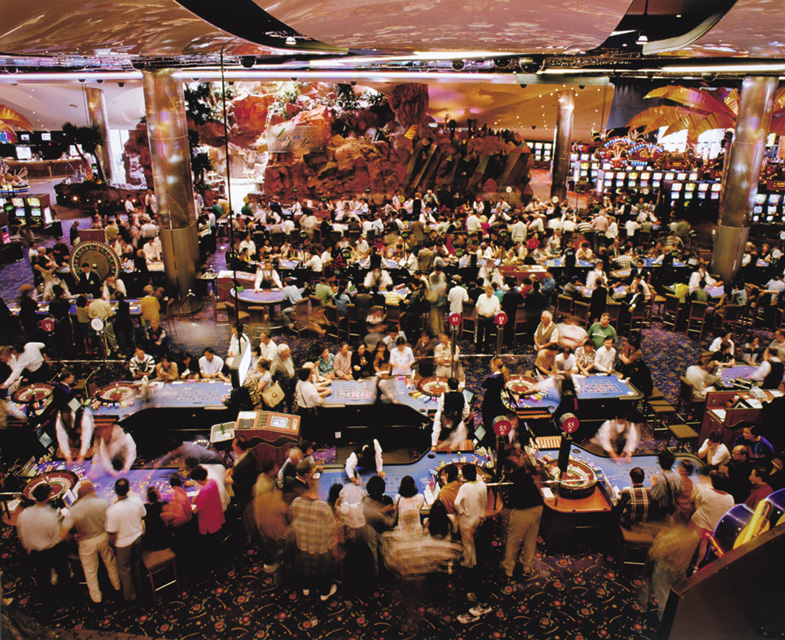


Anne Zahalka creates photographs that play with the conventions of Australian and European art and popular visual culture. In doing so she portrays a culture, its people and places, plundering old myths of national and personal identity and revealing new ones. Star City Casino (1998) is a work from a suite of photographs titled 'Leisureland'. The 'Leisureland' photographs are all images of spectacular forms of popular Australian entertainment and leisure: the casino; the IMAX theatre; an aquatic centre; a wood-chopping tournament; and a demolition derby featuring 'Robosaurus', the first 'car-nivorous' robot.
Most of the photographs were shot from above and at a distance, emphasising the smallness of the humans in comparison to the overwhelming scale and spectacle of the show or attraction. Leisure here is portrayed not from the perspective of the individual’s experience, but as a commodity and a highly orchestrated corporate production.
Star City Casino is shot with a wide-angle lens. The perspective is like that of a company director who surveys the operation from above, monitoring the floor traffic and action on the tables, maximising profits and minimising susceptibility to loss through careful surveillance of the clientele and staff. This all-encompassing aerial view also encourages an interpretation of Star City Casino, located in Sydney, in the context of the social cost of prolific growth of casinos and problem gambling across Australia. We are not close enough to the action to see individual winnings and losses. However, this work demonstrates the phenomenal level of public manipulation that a spectacular, luxurious, brash and well-designed gambling operation can achieve.
Star City Casino is one of the more political works in the ‘Leisureland’ series, but they all encourage an outsider’s view on the way Australians like to spend their free time. They encapsulate a telling aspect of a people and a culture in a single image. This quality is in part derived from the influence of postcards. Zahalka says:
I was inspired by a catalogue I came across of the postcard photography work of John Hinde studios, who produced postcards in the 1950s and 1960s in the UK. What is striking about these postcards is that they manipulated the colours, exposures and scenes to create 'dazzling' hyper-real images. He was the first to do this. I wanted 'Leisureland' to capture the hyper-real nature of these scenes and found that the photographs produced this quality without manipulation. I've tried to be faithful to the environments and not tamper with them.1
Zahalka's non-manipulation of the images is in keeping with the documentary nature of the 'Leisureland' series and is also enabled by the already spectacular nature of her subjects. However, many of her other projects are elaborately staged appropriations of famous European and Australian works of art. One of the most well known is The sunbather #2, (1990), a reworking of Max Dupain's Sunbaker (1937). In this photograph, Dupain's masculine, strong, sun-bronzed Aussie is replaced with an androgynous, fragile, pale, ginger-haired bather. The sunbather #2 explicitly represents the difference between the classic Australian ideal with a contemporary reality
Zahalka’s technique bears the trademark postmodern strategy: the appropriation and revision of the conventions of art history and popular visual culture. However, her true relevance lies in her ability to represent a clear, perceptive and evocative visual commentary on people, places and cultures.
- Lara Travis
Anne Zahalka is represented in Australia by ARC ONE Gallery, Melbourne.